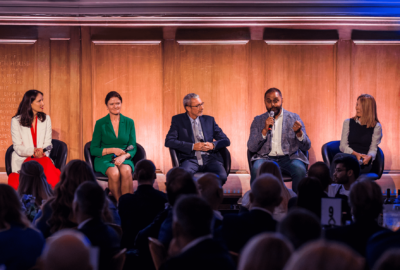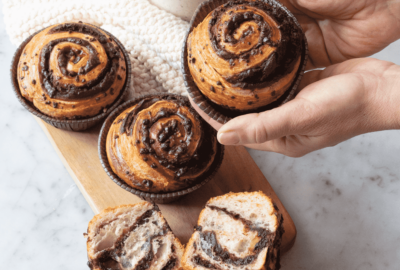It’s official – we’re a nation of chocoholics! According to research by Datamonitor, UK consumers munch more chocolate than any other European nation, with the average Brit devouring over 11kg of the stuff last year. To capitalise on this addiction, caterers need to get creative with this key ingredient. Here, five chefs share their meltingly marvellous tips…
Simon Wood, MasterChef 2015 winner and executive chef at Oldham Athletic FC www.oldhameventcentre.co.uk www.simonwoodcooks.com Adding chocolate to savoury dishes is something I’ve always done. A lot of people add a bit of cocoa powder to chilli but they don’t really know why. Chocolate adds a different dimension to savoury dishes and really brings out the flavour in the same way that adding a bit of salt to desserts does. The first chocolate-based main course I did was Rabbit à la Médoc, which I cooked on MasterChef, and is actually an Elizabeth David recipe from the 1950s so the concept has been around for a long time. My new book features a recipe for Mole Chicken with Holy Guacamole (pictured above), which is essentially chicken in a spicy chocolate sauce. It’s really easy to make. The sauce is made from dried Ancho chillies (rehydrated with boiling water), dark chocolate, cocoa, unsalted peanuts, paprika, cumin, cinnamon and chilli powder – all whizzed up in a food processor until smooth. Then you cook it out gently on a low heat and it can be used as a marinade or dipping sauce and can be frozen so you can make it in batches.
Ernst van Zyl, owner and chef at the Lord Clyde in Kerridge, Cheshire Chocolate contains about 1,500 different aroma molecules and, during the chocolate making process, most develop caramel and fruity aromas so it’s not surprising that chocolate and fruit make great combinations. But it’s the unexpected pairings that are the most interesting to me and can include vegetables, cheeses, vinegars, some meats and even some seafood too. It’s important to remember that 50% cocoa has the perfect balance between sweet and bitter, whereas chocolate with 70% cocoa leans much more to the bitter side. So a fabulous but unlikely pairing for a bitter chocolate could be slow-roasted onions – the cooking process brings the sweetness out in the onions, which the bitter chocolate really complements. Other ideas include fried bacon or roasted vegetables such as parsnip and beetroot (where the sweet notes are present) or roasted cauliflower, as this matches the chocolate’s caramel notes. On the other hand you have white chocolate, which is very sweet and that makes a wonderful match for caviar.
Beverley Dunkley, head of Callebaut’s Chocolate Academy With a change in eating habits, such as the fact food on-the-go and all-day dining are on the rise, traditional chocolate options are no longer satisfying the market so caterers need to think about how they can further incorporate chocolate in order to maximise profits. Sharing platters for example, encourage sales from customers who may not have been able to fit in a full-size dessert, while over half of consumers would also be more likely to order dessert if a mini taster was offered with a drink at the end of a meal. To support operators in encapsulating these trends on their menus, we’ve created a range of innovative recipes including Tear & Share Doughballs with Dark Chocolate Sauce for a sharing platter, and Passion Fruit & White Chocolate Drink with Choux Pastry, which ticks the boxes for smaller desserts people can have with a beverage. www.fortheloveofchoc.com
Sarah Barber, executive pastry chef at Café Royal, which recently opened London’s first dessert restaurant www.hotelcaferoyal.com My top tip for working with chocolate – use a good thermometer and good quality chocolate is key. My jaffa cake (pictured above) is very unique. It is composed of mandarin pate’ d’ fruit jam, almond pain de gene sponge with a chocolate orange ganache covered in a glossy chocolate golden glaze. To create the perfect glaze on the jaffa cake I heat the chocolate glaze to 31.5°C, then use a large ladle to completely cover the jaffa cake. I then take gold shiny powder mixed with mandarin liqueur, and use a toothbrush to create the flick effect on the top of the bar – the fine brushes of the toothbrush allow for a much more detailed, finer finish on the end product.
Ruth Hinks, UK World Chocolate Master and owner of the Chocolate & Pastry School in Peebles, Scotland www.cocoablack.com Ruth’s top tips for working with chocolate:
1. Chocolate should be enjoyed at room temperature.
2. Melt chocolate in a plastic bowl in the microwave (rather than a bain marie).
3. Chocolate should be stored in cool, dry conditions (15-18°C) away from strong odours.
4. Always use the chocolate advised in the recipe.
5. If you learn one chocolate skill, make it tempering.
6. Never store chocolate in the fridge.
7. Tempered chocolate can be used to create beautiful showpieces.
8. Chocolate can be flavoured with essential oils.
9. When colouring chocolate, always use fat soluble food colouring.
10. Avoid cheap chocolate. Quality always beats quantity.


